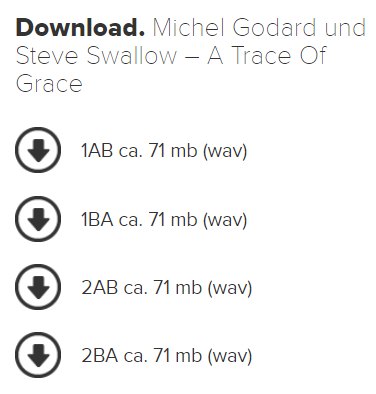The German Magazine "Hi-Fi Statement" has run a series of tests involving changing the direction of the actual USB cable, and has provided audio examples for comparison
Their article reads:
When playing music files, the data is sent from the computer, streamer or streaming bridge with USB-A socket to the converter with USB-B socket in almost all applications. With A / D converters and CD drives for ripping CDs, the data flows to the computer, which then creates a file. If attention is paid to the running direction when manufacturing USB cables - and this is what most cable manufacturers claim for their products - the USB cable would have to be optimized either for the connection to the D / A converter or to the computer. Unfortunately, due to the assembly with USB-A or USB-B connectors, such a cable cannot simply be turned around.
His colleague J?rgen Saile's recently discovered enthusiasm for mobile high-end and the resulting need to convert CDs into files was a reason to take another look at ripping and purchase the Melco D100 including the SBooster MKII, known as the editorial ripper. A MacBook Pro with dBpoweramp then converts the read data into a file. The Melco has a USB-3-B socket for data transfer to the computer, which, as I have now learned, also accepts the usual USB-B plug.
The only thing missing for our experiment is the corresponding cables with a different direction than the usual one. So I turned to two specialists: Robert Hay from Audioquest and Martin Cobb from the Chord Company could not say with certainty whether the direction of travel really played a role with USB cables, but at the same time they asserted that their companies as with all cables also paid close attention to the direction of travel when making USB connections. And that aroused her curiosity for this topic. After that, it didn't take any special persuasion to get them to have a cable made with a different direction than the usual one: For our comparison we have two Audioquest Carbon at a price of 185? for a length of 1.5 meters and two Chord Company shawlines of similar length. Here the meter price is 250?.
For copyright reasons I can only offer you one very familiar song: Michel Godard's ?A Trace Of Grace?. I burned it on an MFSL Gold CD-R and then let the Melco D100 read the data. Then it went one after the other via the four USB cables to an older MacBook Pro with dBpoweramp, which stored the files on a one terabyte SSD. I then uploaded the four files to the hifistatement server.
And now it's your turn!

Files:
1AB - http://www.hifistatement.info/downloads/20-07-14_usb/01-Michel-Godard-A-Trace-Of-Grace-1AB.wav
1BA - http://www.hifistatement.info/downloads/20-07-14_usb/01-Michel-Godard-A-Trace-Of-Grace-1BA.wav
2AB - http://www.hifistatement.info/downloads/20-07-14_usb/01-Michel-Godard-A-Trace-Of-Grace-2AB.wav
2BA - http://www.hifistatement.info/downloads/20-07-14_usb/01-Michel-Godard-A-Trace-Of-Grace-2BA.wav
https://www.hifistatement.net
Their article reads:
When playing music files, the data is sent from the computer, streamer or streaming bridge with USB-A socket to the converter with USB-B socket in almost all applications. With A / D converters and CD drives for ripping CDs, the data flows to the computer, which then creates a file. If attention is paid to the running direction when manufacturing USB cables - and this is what most cable manufacturers claim for their products - the USB cable would have to be optimized either for the connection to the D / A converter or to the computer. Unfortunately, due to the assembly with USB-A or USB-B connectors, such a cable cannot simply be turned around.
His colleague J?rgen Saile's recently discovered enthusiasm for mobile high-end and the resulting need to convert CDs into files was a reason to take another look at ripping and purchase the Melco D100 including the SBooster MKII, known as the editorial ripper. A MacBook Pro with dBpoweramp then converts the read data into a file. The Melco has a USB-3-B socket for data transfer to the computer, which, as I have now learned, also accepts the usual USB-B plug.
The only thing missing for our experiment is the corresponding cables with a different direction than the usual one. So I turned to two specialists: Robert Hay from Audioquest and Martin Cobb from the Chord Company could not say with certainty whether the direction of travel really played a role with USB cables, but at the same time they asserted that their companies as with all cables also paid close attention to the direction of travel when making USB connections. And that aroused her curiosity for this topic. After that, it didn't take any special persuasion to get them to have a cable made with a different direction than the usual one: For our comparison we have two Audioquest Carbon at a price of 185? for a length of 1.5 meters and two Chord Company shawlines of similar length. Here the meter price is 250?.
For copyright reasons I can only offer you one very familiar song: Michel Godard's ?A Trace Of Grace?. I burned it on an MFSL Gold CD-R and then let the Melco D100 read the data. Then it went one after the other via the four USB cables to an older MacBook Pro with dBpoweramp, which stored the files on a one terabyte SSD. I then uploaded the four files to the hifistatement server.
And now it's your turn!

Files:
1AB - http://www.hifistatement.info/downloads/20-07-14_usb/01-Michel-Godard-A-Trace-Of-Grace-1AB.wav
1BA - http://www.hifistatement.info/downloads/20-07-14_usb/01-Michel-Godard-A-Trace-Of-Grace-1BA.wav
2AB - http://www.hifistatement.info/downloads/20-07-14_usb/01-Michel-Godard-A-Trace-Of-Grace-2AB.wav
2BA - http://www.hifistatement.info/downloads/20-07-14_usb/01-Michel-Godard-A-Trace-Of-Grace-2BA.wav
https://www.hifistatement.net
